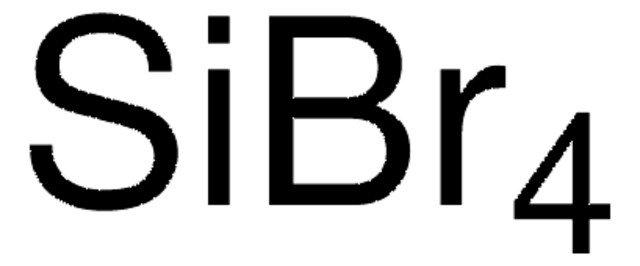249920
Silicon tetrachloride solution
1.0 M in methylene chloride
Iniciar sesiónpara Ver la Fijación de precios por contrato y de la organización
About This Item
Fórmula lineal:
SiCl4
Número de CAS:
Peso molecular:
169.90
Número MDL:
Código UNSPSC:
12352103
ID de la sustancia en PubChem:
NACRES:
NA.23
Productos recomendados
densidad de vapor
5.86 (vs air)
Formulario
liquid
concentración
1.0 M in methylene chloride
densidad
1.34 g/mL at 25 °C
cadena SMILES
Cl[Si](Cl)(Cl)Cl
InChI
1S/Cl4Si/c1-5(2,3)4
Clave InChI
FDNAPBUWERUEDA-UHFFFAOYSA-N
Categorías relacionadas
Palabra de señalización
Danger
Frases de peligro
Consejos de prudencia
Clasificaciones de peligro
Acute Tox. 4 Inhalation - Carc. 2 - Eye Dam. 1 - Skin Corr. 1A - STOT SE 3
Órganos de actuación
Central nervous system
Riesgos supl.
Código de clase de almacenamiento
8A - Combustible corrosive hazardous materials
Clase de riesgo para el agua (WGK)
WGK 2
Punto de inflamabilidad (°F)
Not applicable
Punto de inflamabilidad (°C)
Not applicable
Elija entre una de las versiones más recientes:
¿Ya tiene este producto?
Encuentre la documentación para los productos que ha comprado recientemente en la Biblioteca de documentos.
Los clientes también vieron
Claudio Curti et al.
Organic letters, 13(17), 4738-4741 (2011-08-13)
Virtually perfect transmittal of the enolate reactivity up to five conjugated double bonds from the origin allows a series of furan-based silyloxypolyenes to add to aldehyde carbonyls at the most distant point of the molecule. Denmark's axially chiral bisphosphoramide/SiCl(4) combination
T Kapias et al.
Journal of hazardous materials, 81(3), 209-222 (2001-02-13)
Silicon tetrachloride is a toxic, corrosive water reactive substance that is used widely in the process industries. On spillage from containment it creates liquid pools that can either boil or evaporate. The main feature of the pool behaviour is the
Roman A Sandler et al.
Journal of vision, 15(9), 16-16 (2015-08-01)
Receptive field identification is a vital problem in sensory neurophysiology and vision. Much research has been done in identifying the receptive fields of nonlinear neurons whose firing rate is determined by the nonlinear interactions of a small number of linear
Sang Ho Lee et al.
Journal of the American Chemical Society, 127(25), 9071-9078 (2005-06-23)
A series of four asymmetrically aryl-substituted 9,9'-spiro-9-silabifluorene (SSF) derivatives, 2,2'-di-tert-butyl-7,7'-diphenyl-9,9'-spiro-9-silabifluorene (PhSSF), 2,2'-di-tert-butyl-7,7'-dipyridin-2-yl-9,9'-spiro-9-silabifluorene (PySSF), 2,2'-di-tert-butyl-7,7'-dibiphenyl-4-yl-9,9'-spiro-9-silabifluorene (BPhSSF), and 2,2'-di-tert-butyl-7,7'-bis(2',2' '-bipyridin-6-yl)-9,9'-spiro-9-silabifluorene (BPySSF) are prepared through the cyclization of the corresponding 2,2'-dilithiobiphenyls with silicon tetrachloride. These novel spiro-linked silacyclopentadienes (siloles) form transparent and stable
J R Piascik et al.
Dental materials : official publication of the Academy of Dental Materials, 25(9), 1116-1121 (2009-04-21)
The overall goal of this research was to develop a practical method to chemically modify the surface of high strength dental ceramics (i.e. zirconia) to facilitate viable, robust adhesive bonding using commercially available silanes and resin cements. Investigation focused on
Nuestro equipo de científicos tiene experiencia en todas las áreas de investigación: Ciencias de la vida, Ciencia de los materiales, Síntesis química, Cromatografía, Analítica y muchas otras.
Póngase en contacto con el Servicio técnico











